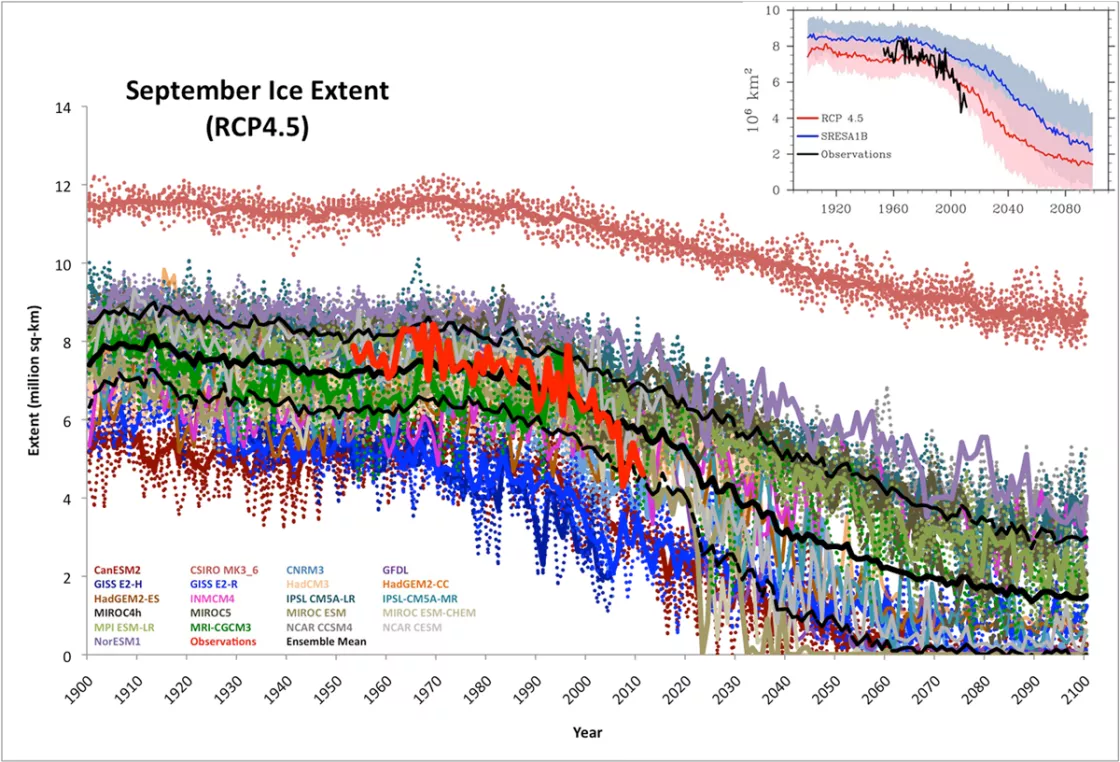By Jane Beitler
The rapid retreat and thinning of the Arctic sea ice cover over the past several decades is one of the most striking manifestations of global climate change. As the ice left at the end of each summer continues its sharp downward trend, setting a new record low in 2012, scientists want to understand exactly what this means for the Arctic and for Earth’s climate as a whole. One of the grand challenges in understanding summer sea ice decline is the question of how soon the Arctic Ocean could become virtually ice-free by summer’s end. An Arctic Ocean with only discontinuous patches of ice floes is thought of as a marker of fundamental change in the Arctic climate system. More of the darker ocean surface would be exposed for a longer time, absorbing the Sun’s heat and then transmitting that heat back to the air and land. A warmer Arctic also portends warmer lower latitudes, as the Arctic weakens in its role as Earth’s air conditioner.
Modeling the decline
Computer climate models help strengthen researchers’ understanding of how Arctic sea ice loss feeds back warming into the Earth system. The models are built on current understanding of the system and past observations. Researchers can use the models to run scenarios with less sea ice cover, increased greenhouse gases in the atmosphere, and other inputs that could affect climate. When the Arctic may become ice free is but one of the important questions that they may use the models to study.
But tuning these climate models is a work in progress, given that scientists are modeling a moving target. One test of the models is how well they simulate current climate conditions. Previous studies revealed that the actual downward trend in September ice extent exceeded simulated trends from most models participating in the World Climate Research Programme Coupled Model Intercomparison Project Phase 3 (CMIP3). Since then, researchers have worked to refine the models. A new study led by NSIDC scientist Julienne Stroeve shows that as a group, simulated trends from the next generation of models, CMIP5, are more consistent with observations over the satellite era (1979 to 2011). So researchers may be closer to an accurate picture of sea ice decline, yet that picture remains elusive.
Exceeding expectations
While closer, the trends from most models nevertheless remain smaller than the observed rate of decline. As of September 2012, satellite data indicated that September Arctic sea ice is currently declining at a rate of -13% per decade, compared to the 1979 to 2000 average. Modeling sea ice thickness continues to be a challenge. Thinning sea ice impacts its ability to survive the melt season, and ice thickness depends on complex factors such as rates of ice transport by winds and ocean currents, and ice melt and growth. As well, natural variability remains a factor in sea ice decline, and by its nature is hard for models to account for. This means that a prolonged series of warmer or colder years could considerably accelerate or delay ice-free summers. Still, it is clear that if greenhouse gas concentrations continue to rise, the Arctic Ocean will eventually become seasonally ice free. While the models still do not provide a certain date, the CMIP5 models are presently suggesting that the Arctic will be seasonally ice-free Arctic sooner than 2035, what the previous model ensemble version CMIP3 suggested.
Reference
Stroeve, J. C., V. Kattsov, A. Barrett, M. Serreze, T. Pavlova, M. Holland, and W. N. Meier (2012), Trends in Arctic sea ice extent from CMIP5, CMIP3 and observations, Geophys. Res. Lett., 39, L16502, doi:10.1029/2012GL052676.

